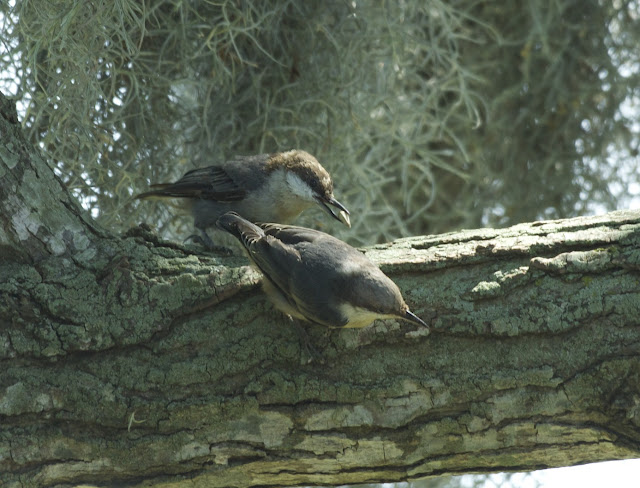Carolina is a great state for birding. It's not California or Texas, nor even Arizona in terms of diversity, but its mountains and its plains and its coast still offer some of the best birding opportunities in the lower 48, especially considering how pretty the surrounding country is (Texas and Arizona cannot always make similar claims). What makes my time birding there even more exciting is that many of the areas where I visit are relatively unestablished on eBird, and as such I can play out my Lewis & Clark naturalist explorer fantasies (the PG-13 ones) with great fulfillment.
Goose Creek SP is the largest hotspot in my area with about 170 species recorded in total, including a very impressive Shiny Cowbird from 2006. However, in the last 10 years in June, this site had nearer a dozen species recorded. A big site like this? In June? It's a sure thing. There will be many species of bird there, and I can still pretend to be a helpful contributor to citizen science (by confirming what people already would have predicted). For example, nor June records of Common Yellowthroat in the last 10 year? Not any more!!
No June records of two squirrels sitting on a stump in June in the last 10 years? Oh. Well here are some more anyway. Anyhow you get the idea. It's rewarding to explore a place with that burgeoning sense of discovery again, not knowing what all one might find, but knowing one will find a lot, and not just of ticks crawling up the thighs.
The GC SP is predominantly a deciduous/hard woodland preserve off of the Pamlico River mouth, but this means there's coastal marsh and brackish swamp habitat winding through the preserve. Are you thinking what I'm thinking? Prothonotary Warbler is the correct thought, the loud-singing face-melting I-don't-care-how-close-you-are-on-the-boardwalk Warbler. Icepacks and wardrobe changes were in order.
PRWAs are superlative and typically accommodating, but their accompanying mosquito clouds really make a fellow feel unwelcome. Even taking into consideration the crevace-invading ticks one picks up in the grass, the woodland areas are more comfortable and not without certain quaint, atavistic amenities.

The telephone is located adjacent to a designated graveyard for people that died from yellow fever in the early 1800s--make of that what you will.
The wooded areas, as one would expect, were teeming with Cardinals, Jays, and Robins, as well as Vireo species, Flycatchers, and Gnatcatchers. Downy Woodpeckers were both present and small, commensurate to expectation, as were Red-headed Woodpeckers correspondingly present and retiring.


It's still foreign, even a bit awkward, to stand on sandy coast and look up into pine trees, but that is much the experience in Carolina on down through Florida. Pines don't naturally grow below 3500 feet or so in Arizona, but I guess it's only appropriate that where they grow at sea level out east, they also bring bird species whose western counterparts are found in similarly higher elevation.
Yellow-throated Warbler is the sexier, longer-billed, longer-winded counterpart to our pine-loving Grace's Warblers out west. Like Grace's Warblers and unscrupulous junkies, they simply go where the needles are, and out east that doesn't require the same elevation.
YTWA was one of my main targets for the area, knowing that it would be suitable habitat, this would be only the second time I saw the species, and I had no pictures from the first encounter. The 3 different individuals I logged this time were good sports about it, with one of them even singing/buzzing on territory in a mucho gorgeous way.
There were lots of Acadian Flycatchers around, as well as Eastern Wood-Pewees. Neither posed well nor had much good to say, so I shall return the favor.
Poking around the understory did turn up a few other good ones, including some goofy Ovenbirds. These birds were not quite skulk-meisters of the KEWA or SWWA variety, but they were still pretty withdrawn, and sometimes creepy.
The Goose Creek SP opens up onto the Pamlico River with a small designated swim area, but enough shoreline to walk along the brackish tidal flats a good ways east and west. The offshore waters are littered with crab pods, and the near-shore tree skeletons are littered with Osprey nests, many of which are impressive in size.

With their reeking cattail marshes, the tidal flats are also good for Rail species, although I arrived too late in the day for much luck beyond truncated audio. Indigo Buntings were good sports, continuing their excellent recent PR campaign with B's Bs. Great-crested Flycatchers continued their suspicious cold-shouldering, so to each their own.
Many of the pine and oak trees in Carolina are littered with Spanish moss, the zany moss that just won't quit. According to the wikipedia machine, Spanish moss--also known as the 'jellyfish plant' and 'Old-Man Winter's pit hair'--is neither lichen nor moss, but a species of bromeliad plant that populates both with tiny, inconspicuous flowers and by colonizing other trees when fragments of its chains drift onto other hosts. Other fun fact: it's often used by Brown-headed Nuthatches as drapery.
There are a couple of bothersome things about my time birding in Carolina these last couple years. One is that I have still not seen Scarlet Tanager nor American Redstart (both birds that I first logged, inappropriately, in Arizona) and I am bereft of Orioles. A nifty Orchard Oriole helped assuage my disillusionment about these failings a bit, where are those Baltimores at?
I probably need to branch out with more habitats and hotspots, but it's hard to walk away from the diversity of a place like Goose Creek SP. Sometimes birding requires sacrifice. Sometimes it requires hard work. There are dark times ahead.


















